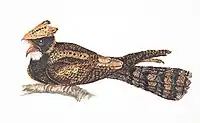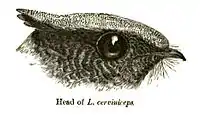Great eared nightjar
The great eared nightjar (Lyncornis macrotis) is a species of nightjar in the family Caprimulgidae. It is found in southwest India and in parts of Southeast Asia. This very large nightjar has long barred wings, a barred tail and long ear-tufts which are often recumbent. It has a white throat band but has no white on its wings or on its tail.
| Great eared nightjar | |
|---|---|
_(2).jpg.webp) | |
| L. m. macropterus from Sulawesi | |
| Call of L. m. bourdilloni recorded in Vazhachal, Kerala, India | |
| Scientific classification | |
| Domain: | Eukaryota |
| Kingdom: | Animalia |
| Phylum: | Chordata |
| Clade: | Dinosauria |
| Class: | Aves |
| Clade: | Strisores |
| Order: | Caprimulgiformes |
| Family: | Caprimulgidae |
| Genus: | Lyncornis |
| Species: | L. macrotis |
| Binomial name | |
| Lyncornis macrotis (Vigors, 1831) | |
| Synonyms | |
| |
Taxonomy
The great eared nightjar was formally described in 1831 by the Irish zoologist Nicholas Aylward Vigors based on a sample collected in the neighbourhood of Manila in the Philippines. Vigors coined the binomial name Caprimulgus macrotis.[2] The great eared nightjar was formerly placed in the genus Eurostopodus. It and the closely related Malaysian eared nightjar were moved to the resurrected genus Lyncornis based on the results of a molecular phylogenetic study published in 2010 that found large genetic differences between the great eared nightjar and other species in Eurostopodus.[3][4] The genus name Lyncornis combines the Ancient Greek lunx / lunkos (meaning "lynx") with ornis, meaning "bird". The specific epithet macrotis is from the Ancient Greek makrōtēs, meaning "long-eared" (from makros meaning "long" and ous, ōtos meaning "ear").[5]
Five subspecies are recognised:[3]
- L. m. cerviniceps Gould, 1838 – Bangladesh and northeastern India to southern China, Indochina and northern Malay Peninsula.
- L. m. bourdilloni Hume, 1875 – southwestern India.
- L. m. macrotis (Vigors, 1831) – Philippines (except far west of Visayas; Palawan group, and Sulu Archipelago).
- L. m. jacobsoni Junge, 1936 – Simeulue (west of north Sumatra).
- L. m. macropterus Bonaparte, 1850 – Sulawesi, Sangihe and Talaud Islands (northeast of Sulawesi), Banggai and Sula Island (east of Sulawesi).
Description
The great eared nightjar is the largest species in the family in terms of length, which can range from 31 to 41 cm (12 to 16 in). Males weigh an average of 131 g (4.6 oz) and females weigh an average of 151 g (5.3 oz), making it the second heaviest species in the family after the nacunda nighthawk.[6]
Distribution and habitat
It is found in South Asia and Southeast Asia with populations in the Western Ghats and Sri Lanka,[7] Bangladesh,[1] India, Indonesia, Laos, Malaysia, Myanmar, the Philippines, Thailand, and Vietnam. Its natural habitat is subtropical or moist lowland tropical forests.
Behaviour
Like other nightjars they are active at dusk and at night. They have a distinctive call which includes a sharp tsiik followed by a pause and a two-syllable ba-haaww.
 Painting by Elizabeth Gwillim c. 1801
Painting by Elizabeth Gwillim c. 1801 Head of L. m. cerviniceps
Head of L. m. cerviniceps
Breeding
The nest is a scrape on the ground and the clutch consists of a single egg. The chick is well camouflaged among leaf litter.[8]
References
- BirdLife International (2020). "Lyncornis macrotis". IUCN Red List of Threatened Species. 2020: e.T22689690A181755129. doi:10.2305/IUCN.UK.2020-3.RLTS.T22689690A181755129.en. Retrieved 17 November 2021.
- Vigors, Nicholas Aylward (1831). "Caprimulgus macrotis". Proceedings of the Committee of Science and Correspondence of the Zoological Society of London. 1 (8): 97.
- Gill, Frank; Donsker, David; Rasmussen, Pamela, eds. (January 2022). "Frogmouths, Oilbird, potoos, nightjars". IOC World Bird List Version 12.1. International Ornithologists' Union. Retrieved 25 January 2022.
- Han, K.-L.; Robbins, M.B.; Braun, M.J. (2010). "A multi-gene estimate of phylogeny in the nightjars and nighthawks (Caprimulgidae)". Molecular Phylogenetics and Evolution. 55 (2): 443–453. doi:10.1016/j.ympev.2010.01.023. PMID 20123032.
- Jobling, James A. (2010). The Helm Dictionary of Scientific Bird Names. London: Christopher Helm. pp. 233, 236. ISBN 978-1-4081-2501-4.
- CRC Handbook of Avian Body Masses, 2nd Edition by John B. Dunning Jr. (Editor). CRC Press (2008), ISBN 978-1-4200-6444-5.
- Soysa, W. C., A. A. T. Amarasinghe and D. M. S. S. Karunarathna (2007). A record of the Great Eared Nightjar Eurostopodus macrotis Vigors, 1830 (Aves: Caprimulgidae), from Sri Lanka, Siyoth, 2 (1): 88–90.
- Strijk JS (2004). "Description of the nest and nestling of Great Eared Nightjar Eurostopodus macrotis from Luzon, Philippines" (PDF). Forktail. 20: 128–129. Archived from the original (PDF) on 2011-06-10.
